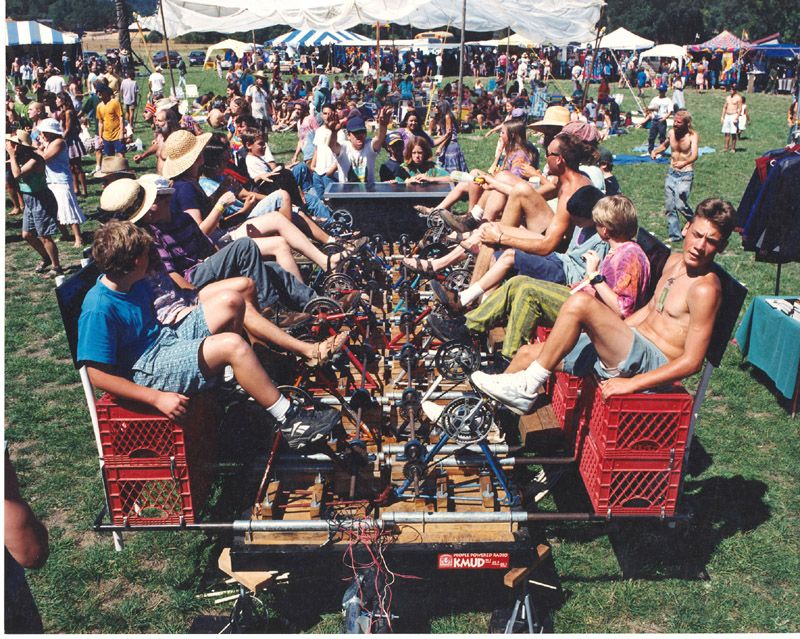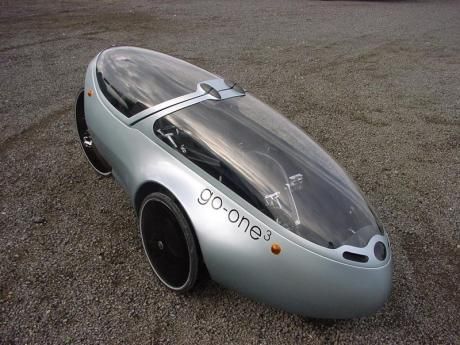Want to watch TV in your living room, but feeling guilty about being inside and growing fat all day? Use an exercise bike, and you can burn up calories while enjoying your favourite on-screen entertainment. Feel like some exercise, but unable to step out your front door due to miserable weather, your sick grandma who needs taking care of, or the growing threat of fundamentalist terrorism in your neighbourhood streets? Use an exercise bike, and you can have the wind in your hair without facing the gale outside. These are just some of the big benefits that you get, either from using a purpose-built exercise bike, or from using a regular bike mounted on a trainer.
Now, how about adding one more great idea to this collection. Want to contribute to clean energy, but still enjoy all those watt-guzzling appliances in your home? Use an electricity-generating exercise bike, and you can become a part of saving the world, by bridging the gap between your quadriceps and the TV. It may seem like a crazy idea, only within the reach of long-haired pizza-eating DIY enthusiasts; but in fact, pedal power is a perfectly logical idea: one that's available commercially for home use by anyone, as well as one that's been adopted for large and well-publicised community events. I have to admit, I haven't made, bought or used such a bike myself (yet) — all I've done so far is think of the idea, find some other people (online) who have done more than just think, and then write this blog post — but I'd love to do so sometime in the near future.
I first thought of the idea of an energy-generating exercise bike several weeks ago: I'm not sure what prompted me to think of it; but since then, I've been happy to learn that I'm not the first to think of it, and indeed that many others have gone several steps further than me, and have put the idea into practice in various ways. Below, I've provided an overview of several groups and individuals who have made the pedal-power dream a reality — in one way or another — and who have made themselves known on the web. I hope (and I have little doubt) that this is but the tip of the iceberg, and that there are in fact countless others in this world who have also contributed their time and effort to the cause, but who I don't know about (either because they have no presence on the web, or because their web presence wasn't visible enough for me to pick it up). If you know of any others who deserve a mention — or if you yourself have done something worth mentioning — then mention away. G-d didn't give us the "add comment" button at the bottom of people's blogs for nothing, you know.
Pedal Power en masse
The Pedal Powered Innovations project is run by bicycle-freak Bart Orlando, with the help of volunteers at the Campus Center for Appropriate Technology (a group at Humboldt State University in northern California). Bart and the CCAT people have been working for over a decade now, and in that time they've built some amazing and (at times) impressively large-scale devices, all of which are very cool applications of the "bicycles as electrical generators" idea.

You can see more photos and more detailed info on their website, but here's a list of just some of the wacky contraptions they've put together:
- Human Energy Converter: multi-bike generator system (the original was comprised of 14 individual bikes), used to power microphones for public speeches, stereo systems for outdoor concerts, and sound-and-light for environmental protests.
- Household appliance generator: various appliances that have been successfully used through being powered by a bicycle. Examples include a blender, a sewing machine, and a washing machine.
- Entertainment device generator: yet more devices that can successfully be bicycle-powered. Examples include TVs, VCRs, and large batteries.
Great work, guys! More than anything, the CCAT project demonstrates just how many different things can potentially be "pedal powered", from the TV in your living room, to the washing machine out back in the laundry, to a large-scale community gathering. It's all just a question of taking all that kinetic energy that gets generated anyway from the act of cycling, and of feeding into a standard AC socket. I'll have to go visit this workshop one day — and to find out if there are any other workshops like this elsewhere in the world.
Pedal-A-Watt in the home
The folks over at Convergence Tech, Inc have developed a commercial product called The Pedal-A-Watt Stationary Bike Power Generator. The product is a trainer (i.e. a holder for a regular road or mountain bike) that collects the electricity produced while pedalling, and that is able to feed up to 200 watts of power into any home device — that's enough to power most smaller TVs, as well as most home PCs. It's been available for 8 years: and although it's quite expensive, it looks to be very high-quality and very cool, not to mention the fact that it will reduce your electricity bill in the long run. Plus, as far as I know, it's almost the only product of its type on the market.

DIY projects
The most comprehensive DIY effort at "pedal power" that I found on the web, is the home-made bicycle powered television that the guys over at Scienceshareware.com have put together. This project is extremely well-documented: as well as a detailed set of instructions (broken down into 10 web pages) on how to achieve the set-up yourself (with numerous technical explanations and justifications accompanying each step), they've also got a YouTube video demonstrating the bike-powered TV. In the demonstration, they show that they were able to not only provide full power to a 50 watt colour TV using a single bicycle; there was also plenty of excess energy that they were able to collect and store inside a car battery. The instructions are very technical (so get ready to pull out those high-school physics and electronics textbooks, guys), but very informative; and they also have no shortage of safety warnings, and of advice on how to carry out the project in your own home reasonably safely.
Another excellent home-grown effort, built and documented last year by the people at the Campaign For Real Events, is their 12-volt exercise bike generator. This bike was originally built for a commercial TV project; but when that project got canned, the bike was still completed, and was instead donated to non-profit community use. The DIY instructions for this bike aren't quite as extensive as the Scienceshareware.com ones, but they're still quite technical (e.g. they include a circuit diagram); and it's still a great example of just what you can do, with an exercise bike and a few other cheaply- or freely-obtainable parts (if you know what you're doing). The Campaign For Real Events group has also, more recently, begun producing "pedal power" devices on a more large-scale basis — except that they're not making them for commercial use, just for various specific community and governmental uses.
Other ideas people
Like myself, plenty of other people have also posted their ideas about "how cool pedal power would be" onto the web. For example, just a few months ago, someone posted a thread on the Make Magazine forum, entitled: How do I build an exercise bike-powered TV? We're not all DIY experts — nor are we all electronics or hardware buffs — but even laymen like you and me can still realise the possibilities that "pedal power" offers, and contribute our thoughts and our opinions on it. And even that is a way of making a difference: by showing that we agree, and that we care, we're still helping to bring "pedal power" closer to being a reality. Not all of the online postings about bicycle-TV combinations are focused on "pedal power", though: many are confined to discussing the use of a bike as an infrared remote control replacement, e.g. triggering the TV getting turned on by starting to pedal on the bike. Also a good idea — although it doesn't involve any electricity savings.
In short, it's green
Yes: it's green. And that's the long and the short of why it's so good, and of why I'm so interested in it. Pedal power may not be the most productive form of clean energy that we have available today: but it's productive enough to power the average electronic devices that one person is likely to use in their home; and (as mentioned above) it has the added benefit of simultaneously offering all the other advantages that come with using an exercise bike. And that's why pedal power just might be the clean energy with less environmental impact, and more added value, than virtually any other form of clean energy on the planet. Plus, its low energy output could also be viewed as an advantage of sorts: if pedal power really did take off, then perhaps it would eventually encourage product manufacturers to produce lower energy-consumption devices; and, in turn, it would thus encourage consumers to "not use more devices than your own two feet can power". This philosophy has an inherent logic and self-sufficiency to it that I really appreciate.
I like cycling. I like this planet. I hope you do too. And I hope that if you do indeed value both of these things, as I do (or that if you at least value the latter), then you'll agree with me that in this time of grave environmental problems — and with dirty forms of electricity production (e.g. coal, oil) being a significant cause of many of these problems — we need all the clean energy solutions we can get our hands on. And I hope you'll agree that as clean energy solutions go, they don't get much sweeter than pedal power. Sure, we can rely on the sun and on photovoltaic collectors for our future energy needs. Sure, we can also rely on the strength of winds, or on the hydraulic force of rivers, or on the volcanic heat emitted from natural geothermal vents. But at the end of the day, everyone knows that if you want to get something done, then you shouldn't rely on anything or anyone except yourself: and with that in mind, what better to rely on for your energy needs, than your own legs and your ability to keep on movin' em?
]]>